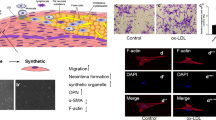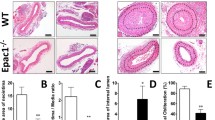Abstract
Purpose
Studies have shown that statins may induce vascular smooth muscle cells (VSMCs) apoptosis. But its mechanisms are incompletely understood. In this study, we investigate the effects of atorvastatin and survivin antisense oligonucleotides (ASODN) on VSMCs apoptosis and the relation between survivin and VSMCs apoptosis.
Materials and methods
Cultured VSMCs were treated with atorvastatin and vascular endothelial grow factor (VEGF). Apoptosis of VSMCs at 6–72 h after treatment with atorvastatin was detected by means of Hoechst33258 staining. Survivin and Fas factors expression were detected by means of immunohistochemistry. Survivin and Fas mRNA expression were detected by means of RT-PCR. In order to determine the relations between survivin and VSMCs apoptosis, we also performed transfection of VSMCs with survivin ASODN using GenePORTER Transfection Reagent and studied the survivin protein expression by means of western blotting.
Results
VSMCs apoptosis after treatment with atorvastatin was increased in a dose- and time-dependent manner. The expression of survivin and survivin mRNA in VSMCs was significantly down-regulated at 24 h and disappeared at 48–72 h after treatment with atorvastatin. Fas and Fas mRNA in VSMCs could only be detected at 72 h and not at 6–48 h after treatment with atorvastatin. We did not observe any effects of VEGF on VSMCs apoptosis, on survivin and survivin mRNA expression, and on Fas and Fas mRNA expression in VSMCs after treatment with atorvastatin. At 48 hours after the start of transfection, survivin protein expression was significantly reduced after transfection with 0.5, 1.0 and 2.0 μg/ml of survivin ASODN and there was no survivin protein expression after transfection with 3.0 and 4.0 μg/ml of survivin ASODN. In contrast, in the GenePORTER only and SODN studies, survivin protein expression was observed with western blotting. Hoechst33258 staining showed that treatment of VSMCs with survivin ASODN resulted in VSMCs apoptosis.
Conclusions
Atorvastatin induces VSMCs apoptosis in a dose- and time-dependent manner. Transfection of survivin ASODN can directly induce VSMCs apoptosis. The mechanisms of VSMCs apoptosis induced by atorvastatin may be mainly associated with down-regulation of survivin expression in VSMCs. Up-regulation of Fas in VSMCs may play a role in later stages following atorvastatin treatment.






Similar content being viewed by others
References
Istvan ES, Deisenhofer J. Structural mechanism for statin inhibition of HMG-CoA reductase. Science 2001;292:1160–4.
Scandinavian Simvastatin Survival Study Group. Randomised trial of cholesterol lowering in 4444 patients with coronary heart disease: the Scandinavian Simvastatin Survival Study (4S). Lancet 1994;344:1383–9.
Maron DJ, Fazio S, Linton MF. Current perspectives on statins. Circulation 2000;101:207–13.
Verschuren L, Kleemann R, Offerman EH, Szalai AJ, Emeis SJ, Princen HMG, et al. Effect of Low Dose Atorvastatin Versus Diet-Induced Cholesterol Lowering on Atherosclerotic Lesion Progression and Inflammation in Apolipoprotein E*3-Leiden Transgenic Mice. Arterioscler Thromb Vasc Biol 2005;25:161–7.
Sukhova GK, Williams JK, Libby P. Statins reduce inflammation in atheroma of nonhuman primates independent of effects on serum cholesterol. Arterioscler Thromb Vasc Biol 2002;22:1452–8.
Schonbeck, U, Libby P. Inflammation, immunity, and HMG-CoA reductase inhibitors: statins as antiinflammatory agents? Circulation 2004;109:18–26.
Liao, JK, Laufs U. Pleiotropic effects of statins. Annu Rev Pharmacol Toxicol 2005;45:89–118.
Ridker PM, Cannon CP, Morrow D, Rifai N, Rose LM, McCabe CH, et al. C-reactive protein levels and outcomes after statins therapy. N Engl J Med 2005;352:20–8.
Davignon J. Beneficial cardiovascular pleiotropic effects of statins. Circulation 2004;109 Suppl III:39–43.
Waehre T, Damas JK, Gullestad L, Holm AM, Petersen TR, Arnesen KE, et al. Hydroxymethylglutaryl coenzyme A reductase inhibitors down-regulate chemokines and chemokine receptors in patients with coronary artery disease. J Am Coll Cardiol 2003;41:1460–7.
Ridker PM, Rifai N, Clearfield M, Downs, JR, Weis SE, Miles JS, et al. Measurement of C-reactive protein for the targeting of statin therapy in the primary prevention of acute coronary events. N Engl J Med 2001;344:1959–65.
Murphy RT, Foley JB, Mulvihill N, Crean P, Walsh MJ. Impact of preexisting statin use on adhesion molecule expression in patients presenting with acute coronary syndromes. Am J Cardiol 2001;87:446–8.
Rezaie-Majd A, Prager GW, Bucek RA, Schernthaner GH, Maca T, Kress HG, et al. Simvastatin reduces the expression of adhesion molecules in circulating monocytes from hypercholesterolemic patients. Arterioscler Thromb Vasc Biol 2003;23:397–403.
Weitz-Schmidt G, Welzenbach K, Brinkmann V, Kamata T, Kallen J, Bruns C, et al. Statins selectively inhibit leukocyte function antigen-1 by binding to a novel regulatory integrin site. Nat Med 2001;7:687–92.
Kiener PA, Davis PM, Murray JL, Youssef S, Rankin BM, Kowala M. Stimulation of inflammatory responses in vitro and in vivo by lipophilic HMG-CoA reductase inhibitors. Int Immunopharmacol 2001;1:105–18.
Han DK, Haudenschild CC, Hong MK, Tinkle BT, Leon MB, Liau G. Evidence for apoptosis in human atherogenesis and in a rat vascular injury model. Am J Pathol 1995;147:267–77.
Guijarro C, Blanco-Colio LM, Ortego M, Alonso C, Ortiz A, Plaza JJ, et al. 3-Hydroxy-3-methylglutaryl coenzyme A reductase and isoprenylation inhibitors induce apoptosis of vascular smooth muscle cells in culture. Circ Res 1998;83:490–500.
Erl W, Hristov M, Neureuter M, Yan ZQ, Hansson GK, Weber PC. HMG-CoA reductase inhibitors induce apoptosis in neointima-derived vascular smooth muscle cells. Atherosclerosis 2003;169:251–8.
Yang L, Gao YJ, Lee RM. The effects of quinapril and atorvastatin on artery structure and function in adult spontaneously hypertensive rats. Eur J Pharmacol 2005;518:145–51.
Stark WW, Blaskovich MA, Johnson BA, Qian Y, Vasudevan A, Pitt B, et al. Inhibiting geranylgeranylation blocks growth and promotes apoptosis in pulmonary VSMCs. Am J Physiol 1998;275:L55–63.
Soma MR, Donetti E, Parolini C, Mazzini G, Ferrari C, Fumagalli R, et al. HMG CoA reductase inhibitors. In vivo effects on carotid intimal thickening in normocholesterolemic rabbits. Arterioscler Thromb 1993;134:571–8.
Sakamoto K, Murata T, Chuma H, Hori M, Ozaki H. Fluvastatin prevents vascular hyperplasia by inhibiting phenotype modulation and proliferation through extracellular signal-regulated kinase 1 and 2 and p38 mitogen-activated protein kinase inactivation in organ-cultured artery. Arterioscler Thromb Vasc Biol 2005;25:327–33.
Cerezo-Guisado MI, Garcia-Marin LJ, Lorenzo MJ, Bragado MJ. Lovastatin inhibits the growth and survival pathway of phosphoinositide 3-kinase/protein kinase B in immortalized rat brain neuroblasts. J Neurochem 2005;94:1277–87.
Altieri DC, Marchisio C. Survivin apoptosis: an interloper between cell death and cell proliferation in cancer. Lab Invest 1999;79:1327–33.
Li F, Ambrosini G, Chu EY, Plescia J, Tognin S, Marchisio PC, et al. Control of apoptosis and mitotic spindle checkpoint by survivin. Nature 1998;396:580–4.
Adida C, Crotty PL, McGrath J, Berrebi D, Diebold J, Altieri DC. Developmentally regulated expression of the novel cancer anti-apoptosis gene survivin in human and mouse differentiation. Am J Pathol 1998;152:43–9.
Yonesaka K, Tamura K, Kurata T, Satoh T, Ikeda M, Fukuoka M, et al. Small interfering RNA targeting survivin sensitizes lung cancer cell with mutant p53 to adriamycin. Int J Cancer 2006;118:812–20.
**a W, Bisi J, Strum J, Liu L, Carrick K, Graham KM, et al. Regulation of survivin by ErbB2 signaling: therapeutic implications for ErbB2-overexpressing breast cancers. Cancer Res 2006;66:1640–7.
Ambrosini G, Adida C, Altieri DC. A novel anti-apoptosis gene, survivin, expressed in cancer and lymphoma. Nat Med 1997;3:917–21.
Takashima H, Nakajima T, Moriguchi M, Sekoguchi S, Nishikawa T, Watanabe T, et al. In vivo expression patterns of survivin and its splicing variants in chronic liver disease and hepatocellular carcinoma. Liver Int 2005;25:77–84.
Blanc-Brude OP, Yu J, Simosa HF, Conte MS, Sessa WC, Altieri DC. Inhibitor of apoptosis protein survivin regulates vascular injury. Nat Med 2002;8:987–94.
Simosa HF, Wang G, Sui XX, Peterson T, Narra V, Altieri DC, et al. Survivin expression is up-regulated in vascular injury and identifies a distinct cellular phenotype. J Vasc Surg 2005;41:682–90.
Wang GJ, Sui XX, Simosa HF, Jain MK, Altieri DC, Conte MS. Regulation of vein graft hyperplasia by survivin, an inhibitor of apoptosis protein. Arterioscler Thromb Vasc Biol 2005;25:2081–7.
Geng YJ, Henderson LE, Levesque EB, Muszynski M, Libby P. Fas is expressed in human atherosclerotic intima and promotes apoptosis of cytokine-primed human vascular smooth muscle cells. Arterioscler Thromb Vasc Biol 1997;17:2200–8.
Li YX, Song YH, Mohler J, Delafontaine P. ANG II induces apoptosis of human vascular smooth muscle via extrinsic pathway involving inhibition of Akt phosphorylation and increased FasL expression. Am J Physiol, Heart Circ Physiol 2006;290:H2116–23.
Tran J, Master Z, Yu JL, Rak J, Dumont DJ, Kerbel RS. A role for survivin in chemoresistance of endothelial cells mediated by VEGF. PNAS 2002;99:4349–54.
Mesri M, Morales-Ruiz M, Ackermann EJ, Bennet CF, Pober JS, Sessa WC, et al. Suppression of vascular endothelial growth factor-mediated endothelial cell protection by survivin targeting. Am J of Pathol 2001;158:1757–65.
Ma X, Wang S, Zhou J, **ng H, Xu G, Wang B, et al. Induction of apoptosis in human ovarian epithelial cancer cells by antisurvivin oligonucleotides. Oncol Rep 2005;14:275–9.
Author information
Authors and Affiliations
Corresponding author
Rights and permissions
About this article
Cite this article
Xu, YG., Zhou, SH., Li, YG. et al. The Mechanism Underlying Vascular Smooth Muscle Cell Apoptosis Induced by Atorvastatin may be Mainly Associated with Down-regulation of Survivin Expression. Cardiovasc Drugs Ther 21, 145–153 (2007). https://doi.org/10.1007/s10557-007-6018-2
Published:
Issue Date:
DOI: https://doi.org/10.1007/s10557-007-6018-2




